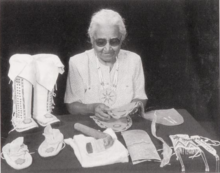Portal:Clothing
The Clothing Portal

Clothing (also known as clothes, garments, dress, apparel, or attire) is any item worn on the body. Typically, clothing is made of fabrics or textiles, but over time it has included garments made from animal skin and other thin sheets of materials and natural products found in the environment, put together. The wearing of clothing is mostly restricted to human beings and is a feature of all human societies. The amount and type of clothing worn depends on gender, body type, social factors, and geographic considerations. Garments cover the body, footwear covers the feet, gloves cover the hands, while hats and headgear cover the head, and underwear covers the private parts.
Clothing has significant social factors as well. Wearing clothes is a variable social norm. It may connote modesty. Being deprived of clothing in front of others may be embarrassing. In many parts of the world, not wearing clothes in public so that genitals, breast, or buttocks are visible could be considered indecent exposure. Pubic area or genital coverage is the most frequently encountered minimum found cross-culturally and regardless of climate, implying social convention as the basis of customs. Clothing also may be used to communicate social status, wealth, group identity, and individualism. (Full article...)
Textile is an umbrella term that includes various fiber-based materials, including fibers, yarns, filaments, threads, different fabric types, etc. At first, the word "textiles" only referred to woven fabrics. However, weaving is not the only manufacturing method, and many other methods were later developed to form textile structures based on their intended use. Knitting and non-woven are other popular types of fabric manufacturing. In the contemporary world, textiles satisfy the material needs for versatile applications, from simple daily clothing to bulletproof jackets, spacesuits, and doctor's gowns. (Full article...)
Textile arts are arts and crafts that use plant, animal, or synthetic fibers to construct practical or decorative objects. (Full article...)
Selected articles -
-
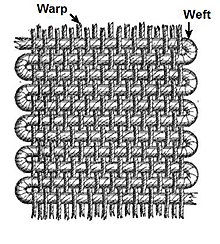
Warp and weft in plain weaving
Weaving is a method of textile production in which two distinct sets of yarns or threads are interlaced at right angles to form a fabric or cloth. Other methods are knitting, crocheting, felting, and braiding or plaiting. The longitudinal threads are called the warp and the lateral threads are the weft, woof, or filling. The method in which these threads are interwoven affects the characteristics of the cloth.
Cloth is usually woven on a loom, a device that holds the warp threads in place while filling threads are woven through them. A fabric band that meets this definition of cloth (warp threads with a weft thread winding between) can also be made using other methods, including tablet weaving, back strap loom, or other techniques that can be done without looms.
The way the warp and filling threads interlace with each other is called the weave. The majority of woven products are created with one of three basic weaves: plain weave, satin weave, or twill weave. Woven cloth can be plain or classic (in one colour or a simple pattern), or can be woven in decorative or artistic design. (Full article...) -

Weaving at Finlayson factory in Tampere, Finland in 1951
Textile manufacturing or textile engineering is a major industry. It is largely based on the conversion of fibre into yarn, then yarn into fabric. These are then dyed or printed, fabricated into cloth which is then converted into useful goods such as clothing, household items, upholstery and various industrial products.
Different types of fibres are used to produce yarn. Cotton remains the most widely used and common natural fiber making up 90% of all-natural fibers used in the textile industry. People often use cotton clothing and accessories because of comfort, not limited to different weathers. There are many variable processes available at the spinning and fabric-forming stages coupled with the complexities of the finishing and colouration processes to the production of a wide range of products. (Full article...) -

An Aran cardigan in the traditional white báinín colour.
The Aran jumper (Irish: Geansaí Árann), also called a fisherman's jumper, is a style of jumper that takes its name from the Aran Islands off the west coast of Ireland. A traditional Aran Jumper usually is off-white in colour, with cable patterns on the body and sleeves. Originally the jumpers were knitted using unscoured wool that retained its natural oils (lanolin) which made the garments water-resistant and meant they remained wearable even when wet.
Use of the word jumper (or other options such as "pullover" and "jersey") is largely determined by the regional version of English used. In the case of Ireland, Britain and Australia, "jumper" is the standard word, “jersey” is used in South Africa and New Zealand, whereas "sweater" is mainly found in tourist shops and in North America. The word used in Irish is geansaí. (Full article...) -

Le Courtisan suivant le Dernier Édit by Abraham Bosse – a French courtier casting aside lace, ribbons and slashed sleeves in favor of sober dress in accordance with the edict of 1633.
Sumptuary laws (from Latin sūmptuāriae lēgēs) are laws that try to regulate consumption. Black's Law Dictionary defines them as "Laws made for the purpose of restraining luxury or extravagance, particularly against inordinate expenditures for apparel, food, furniture, or shoes, etc." Historically, they were intended to regulate and reinforce social hierarchies and morals through restrictions on clothing, food, and luxury expenditures, often depending on a person's social rank.
Societies have used sumptuary laws for a variety of purposes. They were used to try to regulate the balance of trade by limiting the market for expensive imported goods. They made it easy to identify social rank and privilege, and as such could be used for social discrimination and to stabilize social hierarchies. They could also be used to prevent, or at least reduce opportunities for political bribery and corruption. (Full article...) -
Alice Littleman (February 8, 1910 – May 26, 2000) was a Kiowa beadwork artist and regalia maker, who during her lifetime was recognized as one of the leading Kiowa beaders and buckskin dressmakers. Her works are included in the permanent collections of the National Museum of Natural History, the National Museum of the American Indian, the Southern Plains Indian Museum, and the Oklahoma Historical Society. (Full article...) -

A contemporary Navajo rug
Navajo weaving (Navajo: diyogí) are textiles produced by Navajo people, who are based near the Four Corners area of the United States. Navajo textiles are highly regarded and have been sought after as trade items for more than 150 years. Commercial production of handwoven blankets and rugs has been an important element of the Navajo economy. As one art historian wrote, "Classic Navajo serapes at their finest equal the delicacy and sophistication of any pre-mechanical loom-woven textile in the world."
Navajo textiles were originally utilitarian weavings, including cloaks, dresses, saddle blankets, and similar items. By the mid-19th century, Navajo wearing blankets were trade items prized by Indigenous peoples of the Great Plains and neighboring tribes. Toward the end of the 19th century, Navajo weavers began to make rugs for non-Native tourists and for export. (Full article...) -
Courtaulds was a United Kingdom-based manufacturer of fabric, clothing, artificial fibres, and chemicals. It was established in 1794 and became the world's leading man-made fibre production company before being broken up in 1990 into Courtaulds plc and Courtaulds Textiles Ltd. (Full article...)
-

Roller-printed cotton cushion cover panel, 1904, Silver Studio V&A Museum no. CIRC.675–1966
Roller printing, also called cylinder printing or machine printing, on fabrics is a textile printing process patented by Thomas Bell of Scotland in 1783 in an attempt to reduce the cost of the earlier copperplate printing. This method was used in Lancashire fabric mills to produce cotton dress fabrics from the 1790s, most often reproducing small monochrome patterns characterized by striped motifs and tiny dotted patterns called "machine grounds".
Improvements in the technology resulted in more elaborate roller prints in bright, rich colours from the 1820s; Turkey red and chrome yellow were particularly popular. (Full article...) -
The Khalili Collection of Kimono is a private collection of more than 450 Japanese kimono assembled by the British-Iranian scholar, collector and philanthropist Nasser D. Khalili. It is one of eight collections assembled, published and exhibited by Khalili, each of which is considered to be among the most important collections within their respective fields.
The Khalili Collection of Kimono includes formal, semi-formal, and informal kimono made for men, women, and children, illustrating the evolution of the kimono through cut, construction, materials, and decorative techniques from the 17th through the 20th centuries, with kimono representing the Edo period, the Meiji period, the Taishō period, and the Shōwa period. The kimono within the collection are not on permanent display, but are periodically lent or donated in part to cultural institutions; including the Kremlin Museums in Moscow and the Victoria and Albert Museum in London. Khalili, who also owns a collection of Meiji-era Japanese art, describes kimono as "one of the wonders of the world." He started the kimono collection with the aim of collecting and cataloguing cultural works that were not already actively being collected. (Full article...) -
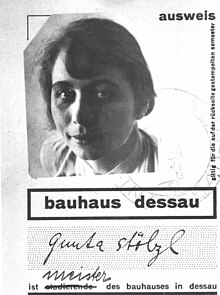
Gunta Stölzl (5 March 1897 – 22 April 1983) was a German textile artist who played a fundamental role in the development of the Bauhaus school's weaving workshop, where she created enormous change as it transitioned from individual pictorial works to modern industrial designs. She was one of a small number of female teachers on the Bauhaus' staff and the first to hold the title of "Master".
Her textile work is thought to typify the distinctive style of Bauhaus textiles. She joined the Bauhaus as a student in 1919, became a junior master in 1927. She was dismissed for political reasons in 1931, two years before the Bauhaus closed under pressure from the Nazis. (Full article...) -

Striking CIO mill workers in Georgia, May 1941.
Emil Rieve (June 8, 1892 – January 24, 1975) was an American labor leader. He was president of the Textile Workers Union of America (TWUA) from 1939 to 1956, a vice president of the Congress of Industrial Organizations (CIO) from 1939 to 1955, and a vice president of the AFL-CIO from 1955 to 1960.
Emil Rieve was born in Poland and moved to Pennsylvania as a child. He left school early and first became a union member at age fifteen, quickly rising within the union hierarchy. He organized his first strike in 1930 in Reading, Pennsylvania. His aggressive drives to unionize the region's textile workers and achieve union recognition led to the Reading Formula of 1933 in negotiating with the National Labor Board, a precedent which resolved large numbers of other labor disputes. Rieve was a major figure in the unsuccessful textile workers strike of 1934. When the Congress of Industrial Organizations formed the following year, Rieve received international recognition for his efforts to avoid a rift with the American Federation of Labor. (Full article...) -
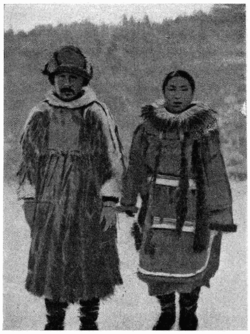
Kusquqvagmiut (Kuskokwim Yup'ik) man and woman wearing hoodless fancy fur parkas (atkupiak), circa 1879
Yup'ik clothing (Yup'ik aturaq sg aturak dual aturat pl, aklu, akluq, un’u ; also, piluguk in Unaliq-Pastuliq dialect, aklu, cangssagar, un’u in Nunivak dialect, Cup'ik clothing for the Chevak Cup'ik-speaking people of Chevak and Cup'ig clothing for the Nunivak Cup'ig-speaking people of Nunivak Island) refers to the traditional Eskimo-style clothing worn by the Yupik people of southwestern Alaska.
The traditional clothing systems developed and used by the Yup’ik, Inuit and Nuniwarmiut peoples performs similarly to the most effective cold weather clothing developed to date. Yup'ik women made clothes and footwear from animal skins (especially hide and fur of marine and land mammals for fur clothing, sometimes birds, also fish), sewn together using needles made from animal bones, walrus ivory, and bird bones such as the front part of a crane's foot and threads made from other animal products, such as sinew. The multi-functional ulu (semilunar woman's knife) is used to process and cut skins for clothing and footwear. Women made most clothing of caribou (wild caribou Rangifer tarandus granti and domestic reindeer Rangifer tarandus tarandus) and sealskin. Yup’ik clothing tended to fit relatively loosely. (Full article...) -

Commercial machine embroidery in chain stitch on a voile curtain, China, early 21st century
Machine embroidery is an embroidery process whereby a sewing machine or embroidery machine is used to create patterns on textiles. It is used commercially in product branding, corporate advertising, and uniform adornment. It is also used in the fashion industry to decorate garments and apparel. Machine embroidery is used by hobbyists and crafters to decorate gifts, clothing, and home decor. Examples include designs on quilts, pillows, and wall hangings.
There are multiple types of machine embroidery. Free-motion sewing machine embroidery uses a basic zigzag sewing machine. Designs are done manually. Most commercial embroidery is done with link stitch embroidery. In link stitch embroidery, patterns may be manually or automatically controlled. Link Stitch embroidery is also known as chenille embroidery, and was patented by Pulse Microsystems in 1994. More modern computerized machine embroidery uses an embroidery machine or sewing/embroidery machine that is controlled with a computer that embroiders stored patterns. These machines may have multiple heads and threads. (Full article...) -

Denim fabric dyed with indigo
Denim is a sturdy cotton warp-faced textile in which the weft passes under two or more warp threads. This twill weave produces a diagonal ribbing that distinguishes it from cotton duck. Denim, as it is recognized today, was first produced in Nîmes, France.
Denim is available in a range of colors, but the most common denim is indigo denim in which the warp thread is dyed while the weft thread is left white. As a result of the warp-faced twill weaving, one side of the textile is dominated by the blue warp threads, and the other side is dominated by the white weft threads. Jeans fabricated from this cloth are thus predominantly white on the inside. Denim is used to create a wide variety of garments, accessories, and furniture. (Full article...) -
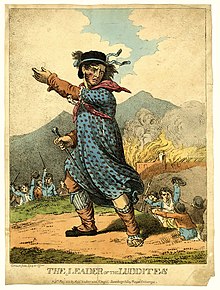
The Leader of the Luddites, 1812. Hand-coloured etching.
The Luddites were members of a 19th-century movement of English textile workers who opposed the use of certain types of automated machinery due to concerns regarding decreased pay for textile workers and a perceived reduction of output quality, and often destroyed the machines in organised raids. Members of the group referred to themselves as Luddites, self-described followers of "Ned Ludd", a mythical weaver whose name was used as a pseudonym in threatening letters to mill owners and government officials.
The Luddite movement began in Nottingham, England, and spread to the North West and Yorkshire between 1811 and 1816. Mill and factory owners took to shooting protesters and eventually the movement was suppressed by legal and military force, which included execution and penal transportation of accused and convicted Luddites. (Full article...)
Did you know (auto generated)

- ... that during a renovation of 4 Park Avenue, workers found a sealed room with women's clothes and shoes that was not in the building's blueprints?
- ... that during the Second World War, the British government's campaign Make-Do and Mend encouraged the public to fashion men's clothes into womenswear?
- ... that after being criticized for dressing "like a doll" at an important meeting, pioneering Russian feminist Anna Filosofova replied that "clothes do not make the woman"?
- ... that Church Clothes 4 deals with Christian hip hop artist Lecrae's faith deconstruction and reconstruction?
- ... that Jacqueline Kennedy did not want to make her clothes the focus of her 1962 goodwill tour of India and Pakistan, but still wore 22 different outfits in the first nine days?
- ... that according to Brandy Hellville, executives at Brandy Melville have bought the clothes off of employees' backs?
More Did you know
- ...that handmade lace often begins as crochet thread (pictured)?
- ...that Flat Top Manor, built by textile industrialist Moses H. Cone in 1900, gets nearly 250,000 visitors annually as the main feature of the Moses H. Cone Memorial Park in North Carolina?
- ...that unmatched dye lots can frustrate weeks of labor for a knitter or crocheter?
Related portals
Selected image

Embroidery hoops and frames are tools used to keep fabric taut while working embroidery or other forms of needlework. In this portrait, Madame de Pompadour works at a floor-standing tambour frame.
General images -
-
Gross sales of goods vs IP laws (US 2007) (from Fashion)
-
Textile machinery at the Cambrian Factory, Llanwrtyd, Wales in the 1940s (from History of clothing and textiles)
-
A see-through top worn along with pasties by a model at a fashion show in US, 2017. Such fashion trends get popularised through media. (from Fashion)
-
Edgar I of England in short tunic, hose, and cloak, 966 (from History of clothing and textiles)
-
Estonian national clothes are a fine example of change in clothing after the Industrial Revolution. They changed a lot during 18th and 19th of century with the addition of new types of colors (like aniline dyes), placement of colors (like lengthwise stripes) and with the addition of new elements (like waistcoats). By the end of the 19th century they went out of use in most of the country (except more remote places as in Kihnu island) and it was only in mid 20th century when they once again gained popularity and now as a formal clothing. Members of University of Tartu Folk Art Ensemble wearing clothes specific to Kihnu island, Tori Parish (women in red skirts) and Tõstamaa area (men in brown clothing). (from History of clothing and textiles)
-
Model with a modern dress reflecting the current fashion trend at a fashion show, Paris, 2011 (from Fashion)
-
The Boxer Codex, showing the attire of a Classical period Filipino, made of silk and cotton (from History of clothing and textiles)
-
Jacqueline Kennedy, the wife of President John F. Kennedy, made pink a popular high-fashion color. (from Fashion)
-
Latin dancers in their costumes. The woman is wearing backless dress with deep slits on its lower portion, while the man is wearing a shirt with top buttons open. (from Fashion)
-
Gensei Kajin Shu by Yoshu Chikanobu, 1890. Various styles of traditional Japanese clothing and Western styles. (from Fashion)
-
Liu Wen, supermodel, walks the runway modeling fashions by designer Diane von Fürstenberg at New York Fashion Week 2013. (from Fashion)
-
Kaia Gerber at the 2019 Max Mara Fashion Week in Milan (from Fashion)
-
A Mexican sports reporter Inés Sainz wearing a little black dress and knee-high boots (from Fashion)
-
Albrecht Dürer's drawing contrasts a well-turned out bourgeoise from Nuremberg (left) with her counterpart from Venice. The Venetian lady's high chopines make her look taller. (from Fashion)
-
A woman in Bengal region in the eastern part of the Indian subcontinent, clad in fine Bengali muslin, 18th century. (from History of clothing and textiles)
-
Bold floral patterned silks, 15th century (from History of clothing and textiles)
-
Timberland boots are an everyday shoe in streetwear. (from Fashion)
-
Indigenous Americas Map Tunic designed in 2018 by Carla Fernández and Pedro Reyes for Taller Flora. (from Fashion)
-
This 1921 clipping from the St. Louis Post-Dispatch, with story and drawings by Marguerite Martyn, represents the saturation newspaper coverage given to society women at a fashionable dance. (from Fashion)
-
14th-century Italian silk damasks (from History of clothing and textiles)
-
A French reinterpretation of Spanish fashion, with elaborate reticella ruff, 1609 (from History of clothing and textiles)
-
Tie dye vendor, July 2013 (from Fashion)
-
Marie Antoinette, wife of Louis XVI, was a leader of fashion. Her choices, such as this 1783 white muslin dress called a chemise a la Reine, were highly influential and widely worn. (from Fashion)
-
Cover of Marcus Clarks' spring and summer catalogue 1926–27 (from Fashion)
-
Celebrities such as Britney Spears have popularized the concept of wearing underwear as outerwear. (from Fashion)
Selected quote
Main topics
Recognized content
Extended content
| ||
|---|---|---|
Featured articlesGood articlesFeatured pictures
Featured portals
|
Subcategories
WikiProjects
- Parent project
- Main project
- Participants
- Related projects
WikiProject Fashion • WikiProject Knots • WikiProject Sculpture • WikiProject Visual arts
What are WikiProjects?
Things you can do
Associated Wikimedia
The following Wikimedia Foundation sister projects provide more on this subject:
-
Commons
Free media repository -
Wikibooks
Free textbooks and manuals -
Wikidata
Free knowledge base -
Wikinews
Free-content news -
Wikiquote
Collection of quotations -
Wikisource
Free-content library -
Wikiversity
Free learning tools -
Wiktionary
Dictionary and thesaurus






